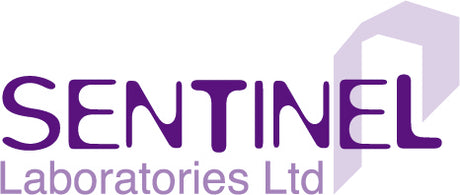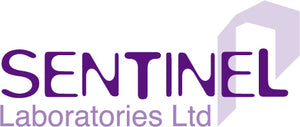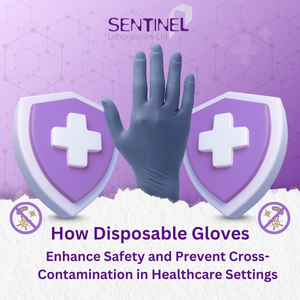Thin Film Nitrile Gloves - Do you have less protection?
Thin Nitrile Gloves
It seems that car manufacturers are all racing to produce new increasingly efficient engines in an effort to improve their vehicles economy. Now they are developing electric, hybrid and even hydrogen powered cars. It is claimed by 2020 we will all be benefiting from a cleaner healthier environment as the traditional petrol and diesel give way to the new technology.
Examination gloves have traditionally been manufactured from natural rubber latex because the technology is relatively easy and the product is exceptionally soft and comfortable in use. So what are the drivers to seek alternative materials?
- Latex allergy
Latex protein in a glove can result in a severe reaction in susceptible individuals. This is a particular problem with powdered latex gloves (rarely used in the U.K) - Powder free gloves have been leached to protein levels less than 50µg/g the level of sensitisation is above 100µg/g. It should be remembered however if an individual has been sensitised in the past when in contact with a high protein glove they may still react to a low protein glove.
- Chemical Resistance
Natural rubber latex gloves have an excellent physical barrier; however do not offer great protection against solvents. Laboratory and industrial customers are demanding greater protection.
- Price
Natural rubber latex is derived from a rubber tree Hevea brasiliensis , the material was collected by low cost labour which meant the raw material was exceptionally low cost. In the past few years world demand for latex has exploded, at a time when plantations are reaching the end of their productive life thus pushing prices up exponentially.
Latex gloves are purchased in US$, so the effect of a rapidly fluctuating $ on the above latex price results in significant price fluctuations of gloves in the market place.
Alternative Materials
The ideal glove would be produced from a material which is soft and comfortable to wear for extended periods and in addition have chemical resistance. One of the key issues is that the material should be not being subject to wild price fluctuations- which in effect would have to be a manufactured material.
|
|
Vinyl |
Nitrile |
Polychloroprene (Neoprene) |
Poly Urethane |
Poly-isoprene |
|
Strengths |
Low cost |
Low cost |
Mid price |
|
|
|
|
Resistant to Oils |
Resistant to Oils |
Resistant to Oils |
Resistant to Oils |
|
|
|
|
Resistant to chemicals |
Resistant to chemicals |
|
|
|
|
|
Resistant to puncture |
Resistant to puncture |
|
|
|
|
|
Tactile Sensitivity |
Tactile Sensitivity |
|
Tactile Sensitivity |
|
Limitations |
Durability |
|
|
|
|
|
|
Elasticity |
|
|
Slippery |
|
|
|
|
|
|
High price |
High price |
From inspection of the above table it is clear that the choice was between nitrile and polychloroprene. As the base price of nitrile is significantly below polychloroprene then clearly nitrile is the material of choice.
History
Nitrile examination gloves were pioneered by Best Manufacturing (Now Showa Best) who developed the first soft nitrile glove approximately 15 years ago. Once the value of nitrile examination gloves was established Ansell introduced Touch & Tuff™ and Safeskin (Now Kimberly Clark) with Blue Nitrile™ and shortly after Purple Nitrile™. These gloves, and later introductions from other manufacturers are premium products aimed at solving specific problems (Chemical Resistance, Latex allergy etc) not really competing directly with latex examination gloves.
Current Developments in Thin Nitrile Examination Gloves
In the past year new nitrile gloves have entered the market aimed at widening the utility of nitrile examination gloves to replace natural rubber latex examination gloves. Although there are just a few new entrants to this market we can expect many others in the future.
Advantages
- Price Thin nitrile examination gloves can compete directly in price with latex examination gloves yet offer significant other benefits.
- Comfort Nitrile softens rapidly on the skin to provide the most comfortable experience even when the glove is used for extended periods
- Tactility Close fitting nitrile provides enhanced tactility – especially with micro roughened fingertips.
- Chemical Resistance Nitrile is inheritably more chemical resistant than latex.
- Improved Heat dissipation The thin film nitrile is able to dissipate heat from the hand faster, reducing sweating and skin irritation

Where t= temperature dissipation
d= thickness of the film
It can be seen that relatively small decreases in the film thickness make a significant increase in heat dissipation.
- Environmental Issues
Thin nitrile gloves offer significant environmental benefits, in storage and transportation. Cases of gloves contain up to twice the quantity in a box this means that a case that would normally hold 1000 gloves may hold 2000 gloves. This results in a reduction of packaging costs. There is also an impact on transportation costs of gloves from the manufacturing site to the distributor, and from distributor to end user. Storage costs throughout the supply chain are similarly reduced. Finally the cost of disposal of used product and packaging to land fill or incineration is significantly reduced.
Nitrile glove production is exceptionally competitive and manufacturers will seek to offer a similar product. Clearly not all will have the technical expertise and modify existing formulations to enable them to enter this fast developing market.
Application of Thin Nitrile Gloves
- Food Preparation
Vinyl disposable gloves for use with food preparation are regulated by 1935/2004/EC, 2007/19/EC and 2008/39/EC. The plasticizers used (phthalates) have been shown to migrate to foodstuffs, particularly fatty foods such as oil, meat and fish. Phthalates are now carefully controlled in gloves used in food preparation; however confirmation from the manufacturer that the gloves are “foods safe” should be secured if you continue to use vinyl. A better alternative is to use thin nitrile gloves which meet the “food safe” requirements.
- Medical, Industrial ,laboratory and Pharmaceutical
Gloves are widely and increasingly used in hospitals and throughout industry - possibly the same supplier providing gloves to all users.
The protection required in a hospital is not the same as that required in industry – basically in a hospital environment the gloves are to protect the patient from the glove user, whereas in industrial applications it is the user who requires protection from what is being handled. Not surprisingly gloves for the different applications require different standards - as these are often confused (or in error used interchangeably) it is worth considering the implications of this. What would be the view taken by an insurance company if a member of staff for example in a laboratory, had an accident whilst using gloves designed for medical use? What would be the defence if a skin problem erupted even years after the event? In order to protect the individual and the company it is wise (and mandatory) to use a glove meeting the correct standards.
Disposable gloves are classified - Council Directive 89/656/EEC for laboratory and industrial gloves and Council Directive 93/42/EEC for the Medical Device Directive.
- Medical Gloves
These will conform to EN455 - a non sterile glove is registered according to the Medical Device Directive are examination gloves. The product is self certified by the manufacturer.
The basic elements of EN455 are:
EN455-1 Water tightness on a batch will meet AQL 1.5 that is approximately 3% defects. This shows the level of protection to the patient.
EN455-2 Covers the physical dimensions and the strength of the glove
EN455-3 Describes the determination of natural rubber latex proteins by aqueous extraction.
On the glove box you will find:

There will also be the statement “Class 1 Medical Device” and a note that the gloves conform to BS EN455:2000
- Industrial, Laboratory and Pharmaceutical Gloves
Gloves to be to be considered as Personal Protection Equipment (PPE) are considered either simple design
(category 1) or complex design (Category 3)- with a Category 2 glove which does not fall into the categories 1 or 3.
The basic elements are:
Category 1 Simple Design- for minimal risk only
Category 3 Complex design- designed to protect against the highest level of risk- irreversible or mortal risk. Disposable glove in this category are designed to protect against chemicals and micro-organisms. These gloves will be evaluated against the following EN420 requirements of a glove, EN374-2 testing for protection against liquid penetration and micro-organisms, EN374-3 testing against chemical permeation. EN388 testing against cut and abrasion.
On the box you will find:

Where the numbers alongside the CE indicate the independent test house- the notified body that carried out the article 11 (a or b) certification of the manufacturing facility to ensure the production quality and monitoring system meets the requirements of the PPE directive ( 0134 Satra, 0120 SGS, 0493 Centexbel, 0123 TUV).
Pictograms on the box indicate tests conducted and the levels achieved. https://www.sentinel-laboratories.com/pages/ppe-pictograms-explained
Of particular interest to us is EN374-2 which is the resistance to penetration- this is particularly important test for laboratory staff using disposable examination gloves as it indicates the barrier properties of the glove. This is normally designated on the box as 0.65, 1.5 or 4, the test is a water tightness test for the determination of holes. This clearly indicates the protection afforded to the user from holes which may allow the ingress of bio-organisms or chemicals into the glove. For laboratory use the minimum standard for a glove should be AQL of 1.5 however if the glove had an AQL of 0.65 this would provide a greater level of security.
The AQL figure is a statistical monitor of production; it is based on the batch size which would tell you the size of a sample of the gloves to be tested for defects.
Thin Nitrile gloves meet the needs of both medical, laboratory and industrial users- the Kimberly Clark KIMTECH SCIENCE* STERLING* Nitrile gloves are available as both a medical and an industrial glove, the Sempermed Xtra-Lite is a “food safe” glove.
So you have told me how good Thin Nitrile Gloves are - What are the drawbacks?
- Chemical Resistance
A significantly thinner glove will clearly allow chemicals to pass through the nitrile film faster. This can be represented by the following formula:

Where P= penetration
d= thickness of the film
Where it can be seen 25% reduction in film thickness can result in as much as 50% reduction in penetration time.
Clearly if you are concerned over chemical resistance then ensure that the chemical resistance data provided by your supplier is as a result of testing that glove material- NOT GENERIC test data which may have been produced 20 years ago on a different formulation of nitrile!
Note Thin film nitrile glove should be used for splash resistance only- the glove should be replaced once it is contaminated.
- Chemical Resistance data
A useful source of information for chemical resistance of gloves based on test data of manufacturers gloves can be found at :
www.Chemrest.com- an excellent site which provides information on suitable gloves and also data on the toxicology of the material
www.anselleurope.com- Provides a comprehensive resource on chemicals also provides information on standards
Sempermed and Kimberly Clark at kimtech.eu provide easy to use chemical resistance guides. This data is on kcprofessional.com
Shield Scientific offers a comprehensive guide and formulate gloves to a technically high standard
- Touch & Feel of the Material
New nitrile formulations have been developed to provide outstanding softness and tactility, whilst retaining exceptional chemical resistance. The developments of the formulations are the result of a significant investment in the technology.
Whilst the established glove companies produce excellent gloves I have become aware that similar level of softness can be achieved by under curing the nitrile film. This can result in a glove which has insufficient mechanical strength; if the tri-dimensional bonding is not complete then weakness in the film will occur. This may appear to give the gloves an exceptionally soft feel but can result in glove failure (ripping when donning the glove) or colour leaching from the glove to the hand.
Future Developments
Nitrile technology is rapidly advancing and a range of developments are predicted:
Nitrile is a “clean” material and post manufacturing washing will produce glove which meets the highest Cleanroom requirements producing a glove which is clean and not subject to shedding, in addition is exceptionally low in residual chemicals. The gloves may be readily sterilised by irradiation without any reduction in physical characteristics. Nitrile Cleanroom gloves are rapidly taking over as the material of choice in Cleanrooms’ with the introduction of the newer thin film nitriles they eliminate the need for latex product.
- Accelerator Free Gloves
Accelerators are used in gloves to ensure a rapid vulcanisation of the film and are responsible for many of the positive characteristics of a glove, strength, elasticity and barrier performance (similar or the same accelerators are used in both natural rubber latex and nitrile latex manufacture). If staff has a problem with the accelerator in a latex glove they may have problems when they use nitrile gloves. Accelerators are linked to Allergic Contact Dermatitis (Type IV, delayed hypersensitivity). These chemicals are in basic three groups of chemicals: thiurams, thiazoles and dithiocaramates- often moving from glove with a different accelerator can reduce or eliminate a problem.
There are available “accelerator free” gloves which utilise optimised manufacturing conditions with exceptionally low levels of accelerator (so low they cannot be leached with water). However when leached with a solvent then accelerators become apparent.
If it were intended that solvents be present in the proposed application then this could pose a potential problem.
I am aware that one manufacturer has developed a pre-treatment of the dip mix which eliminates the requirement of an accelerator; this is the development stage and has yet to be applied to a production line. Certainly this is an interesting development and I am sure that other manufacturers will enter the market for truly accelerator free gloves. Clearly, at present caution should be exercised when individuals who are known to have sensitivity to accelerators use an “accelerator free” glove.
- AQL 0.65
The AQL – Acceptable Quality Limit is a measure of the quality of a glove in terms of water leakage and other defects of a glove. This is assessed by random sampling of a batch which is defined according to the batch size and the quantity of gloves to be analysed. The results provide a statistical probability that the result of the random sample will also be valid for the entire batch- designated the AQL. Where a customer places higher demands on the product they require a glove with a lower AQL.
Glove manufacturers are aware of the increasing interest in gloves which will provide greater security when handling sensitive materials. Examination gloves will normally achieve an AQL of 1.5 however where greater protection is required then an AQL of 0.65 may be preferred. Already a number of manufacturers including Kimberly Clark’s KIMTECH SCIENCE* PURPLE NITRILE* are achieving this standard – it can only be a matter of time before competitive pressure ensures others follow the trend.
I am confident that thin Nitrile Gloves will become established as a product of choice as the benefits of the product become established. They were developed to offer a real alternative to latex gloves which they are already achieving in the medical area- it is a matter of time before they become established as a laboratory and industrial glove. Once the new style nitrile gloves are evaluated the additional benefits of comfort, tactility and added protection will become apparent.
Brian Smith
Director at Sentinel Laboratories Ltd





Leave a comment